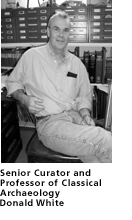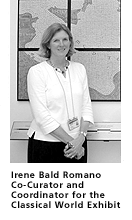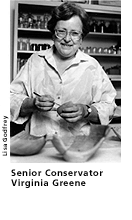
LEGENDS OF THE HALL
TELLING THE STORY OF THE CLASSICAL WORLD
Organizing and transporting scholars and equipment to remote sites around the world make research expeditions formidable undertakings, and sometimes investigators in the field can face unexpected adventures. The first excavation mounted by Penn's Museum of Archaeology and Anthropology in 1887 took place in modern-day Iraq at the site of ancient Nippur, a holy city of the Sumerians. Two months of digging came to a halt when a guard shot an Arab who was stealing mules from the encampment. In retaliation, the camp was burned, the researchers were robbed, and a blood feud was launched against the team of scientists.
Not all of the museum's forays have been worthy of Indiana Jones, but there have been over 350 of them in the institution's 113 year history, making for lots of good storytelling in the faculty club, not to mention a collection of about 1 million artifacts. But reports from the field—even exciting ones—only begin to fulfill one of the museum's main objectives, which is to make sense of what researchers find and then to tell that story to the public.

Telling the Story
"This is a museum that has a didactic mission at its core," declares Donald White, professor of classical archeology and senior curator of the Mediterranean Section. "It sounds rather pompous, but we really have to be able to make our objects tell a story—not
just display them as pretty works of art but put them in some kind of larger context so that people understand they're part of a complex and influential civilization." Trim and fit looking in faded jeans and sandals, White is slouched in an office chair with hands locked behind his head and elbows splayed. He is the curator in charge of a major reinstallation of a four-gallery exhibit on the Classical World.

The first part of the installation, the gallery on the Ancient Greek World, was completed in 1994 and includes some 400 objects. The museum is now at work on three additional galleries, which will be renovated to display 800 more objects to complete the ensemble: the Roman World, the Etruscan World, and a smaller gallery that will serve as an Introduction to the Classical World.

Not nearly as glamorous as an expedition to some exotic place, mounting an exhibit such as this demands comparable organizational and logistical finesse. The four-gallery exhibition is not scheduled to open until October 2002, but many staffers already feel the press of time. Remarks Irene Bald Romano, Gr'80, a co-curator and the coordinator for the exhibit, "Five years ago, people said to us, 'Aren't you starting a little early?' Now it's two years away, and we're all going crazy."
Romano's task is to hold together all the pieces of the effort, making sure the grant writing, fund-raising, conservation, marketing, moving of half-ton sculptures, photography, catalogue composition, and the welter of administrative detail all happen—and happen at the proper time. "Just about everybody in the building is working toward this goal of October 2002," she says, and that doesn't count the exhibit-design firm, the architect, the large sculpture conservator, and other consultants commissioned by the museum.
Every new exhibition begins with the curatorial staff, who together are acquainted with the collection in their charge. The Mediterranean Section has over 30,000 artifacts, mostly in storage. Ann Blair Brownlee, a co-curator and senior research scientist at the museum and Jean MacIntosh Turfa, a curatorial consultant who teaches Etruscan art and archaeology at Bryn Mawr College, are also working on the exhibit.
"For the last year or so," says White, "we have been going through the storage collections and looking with new eyes at what's already on display and getting together a list of what we think would be the most indispensable and most useful objects. Then we try to build them into whatever we feel are the basic story lines that we want to present." The exercise produces a list of objects with text panels for each one and provides a first glimpse of what the display will eventually look like.
To lend uniformity across the galleries of the installation, the curators plan to recapitulate most of the themes that shape the Greek gallery: daily life, trade and manufacturing, religion and the gods, death and burial. When possible, comments White, the strengths in the collection will be exploited to illuminate these themes or to develop motifs within the main story line.
The museum possesses a large collection of cremation urns from Etruria and a number of burial chambers, which will help illustrate the story of how the Etruscans looked at death. Many of the urns hold the original ash remains, and in some cases scholars have determined the age and sex of the deceased. The Etruscans, whose impact on classical culture has become more widely recognized, lived in pre-Roman Italy perhaps as early as the ninth century BC and were absorbed by Roman civilization around the first century BC.
The centerpiece of the Roman gallery will be a second century AD relief panel from the Arch of Trajan (in Puteoli), which depicts armed soldiers from the elite praetorian guard. The sculpture will help illustrate the theme of power and the Roman state. The marble relief was recut from an earlier monument honoring the emperor Domitian, who was assassinated. The inscription on the back has been effaced, the result of an Orwellian proclamation by the Roman Senate that all public memory of the Domitian, who had fallen into official disfavor, be erased.
Items selected from the museum's collection of 45 sculptures that were once part of the Sanctuary of Diana Nemorensis on the shores of Lake Nemi will help to elucidate Roman religion. Over the summer, Romano traveled to the Alban Hills on the outskirts of Rome and took pictures of the volcanic lake where the ancient sanctuary once stood. The photographs will aid exhibit designers in creating the environmental backdrop for the reconstructed sanctuary.

Repair and Preservation
Before any of the 800 objects are put on display, they must first go to the museum's conservation laboratory to be examined by a conservator. Virginia Greene, G'68, the senior conservator, has been the head of the lab since 1971.
Greene has an abrupt, no-nonsense way of expressing herself and would clearly rather be probing at some ancient object in her basement laboratory than be the object of an interviewer's probing. "The [conservator's] field is both an art and a science," she explains. "It's the most marvelous combination of working with your brain and working with your hands. You need to have the manual skills to use micro-tools to do fills, for instance, but you also have to know something about material science—the composition of things: What is a ceramic? How do you make a pot and as a result of the way it's made, what can go wrong? What can you do about it? You also need to know a little about the cultural background of the things you're working on. You have to know some anthropology or you can't talk to the curators to understand what it is they want out of this whole process."
As the collection's caretakers, conservators work with curators, exhibit designers, mount makers, and others to clean and repair objects, to document their condition, and to display them. Conservators also pay close attention to the galleries' environment to control for the deleterious effects of humidity, temperature, and pollution. "We try to balance what the curators want to say, what is physically possible in the space we have available and with the money we have, and what is not going to damage the objects," says Greene.
The Story's Importance
The gallery that introduces the Classical World to museum goers will include a video explaining the origin and intertwining of the three cultures that are the foundation of Western civilization. The introductory gallery will relate how scientists decipher the evidence—the objects on display, which are the remains of these vanished cultures—and it will also highlight the Etruscan, Greek, and Roman legacy that lives on today. Introduction to the Classical World will include photos of classical architecture in Philadelphia—Thirtieth Street Station is essentially a Greek temple, and Girard College is a campus of classical temples, notes Romano. There will also be a photo of a famous statue of George Washington in the toga of a Roman senator, which conveys how this nation's founding fathers viewed what they were trying to accomplish.
 Architecture and representative government are only a tiny portion of our inheritance from the classical past. A preliminary script for the introductory video lists the following, for good and for ill, as part of the legacy from the classical world: language, literature, philosophy, jurisprudence, medicine, agriculture, science, math, music, engineering, mining, road making, ship building, painting, sculpture, coinage, mass war, class strife, slavery, blood sports, prostitution, and more.
Architecture and representative government are only a tiny portion of our inheritance from the classical past. A preliminary script for the introductory video lists the following, for good and for ill, as part of the legacy from the classical world: language, literature, philosophy, jurisprudence, medicine, agriculture, science, math, music, engineering, mining, road making, ship building, painting, sculpture, coinage, mass war, class strife, slavery, blood sports, prostitution, and more.
"If we can do anything to remind people of how important this story is and allow them the opportunity to explore it a bit further," says White, "I think this is a good thing. If we succeed, I think people will come away with a lot of very interesting insights into who they are and what this country is. With any luck, we should end up with something pretty spectacular."